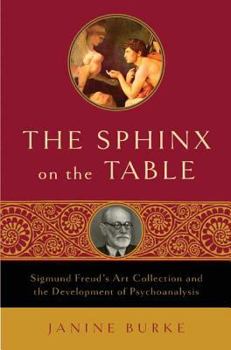The Sphinx on the Table: Sigmund Freud's Art Collection and the Development of Psychoanalysis
Select Format
Select Condition 
Book Overview
Sigmund Freud's collection of Egyptian, Greek and Roman antiquities is one of the art world's best-kept secrets. Over a forty year period he amassed an extraordinary array of nearly three thousand... This description may be from another edition of this product.
Format:Hardcover
Language:English
ISBN:0802715036
ISBN13:9780802715036
Release Date:November 2006
Publisher:Walker & Company
Length:455 Pages
Weight:1.95 lbs.
Dimensions:1.5" x 6.4" x 9.5"
Customer Reviews
2 ratings
Freud/Oedipus & the Sphinx
Published by Thriftbooks.com User , 15 years ago
The Sphinx on the Table by Janine Burke Freud/Oedipus & the Sphinx For those of us for whom Freud is a hero, this beautiful book by Janine Burke not only has 55 fine plates of him & family, his environs & many representations of his vast (2000 pieces) collection of antiquities, but also tells us of some disconcerting faults. This surprising catalog includes: · "[H]is own therapy was shopping" as his wardrobe & collection showed. (2) · He wore out his wife with 6 kids between 1887 & 1895. He believed abstinence was the preferred method of birth control, "not a particularly successful strategy" considering the results. (105-106) · When traveling with his family, he went 1st class, while they went 2nd. (116) · He didn't send his daughters to university & forbade his sons to become doctors. (279) · Although he knew the "mother goddesses once reigned supreme" (53), "women's power was erased" in his theory (7), & this "mother's undisputed darling" "used to suffer indigestion before his regular Sunday morning visits to her." (20, 21) · This father of the "castration complex" had about 17 talismanic Phalluses (PL 15) but no reported vulvas except for that of his Baubo (215) not shown in this book or on the Freud Museum website. But all of us, like our statues, start with feet of clay & it's in the fires of life or kiln or foundry that some become the heroes, terra cottas or bronzes we now idolize. And despite all the faults, this was the man who, in his search for the truth (we are happy to learn that he got his hand back from La Bocca Della Verità! 179) was the foremost pioneer in the discovery & exploration of the unconcious, showed us that dreams had real meaning, that slips of all kinds are the result of various repressions, & that ultimately the notion of god could be traced to infantile helplessness & dependence on the father (The Future of an Illusion. Only through patriarchal prejudice could he have missed the mother in all this.) His notorious & disputed ideas on the primacy of sex in mental & social disturbance at the least brought the subject into the open in a Victorian world & still rattles some of us. Yet, in this sexualized context, we are surprised that his terra cotta winged Eros (PL 7) is unaccompanied by his partner Psyché in this collection of the founder of Psychoanalysis. Freud rejected religion but "could not stop thinking about it." (128) "Indeed, his collection fetishises religion through its obsessive accumulation of sacred objects." (129) "He happily surrounded himself with old and grubby gods" (139) & goddesses. For example, the noble bronze Head of Osiris (PL 21), which reminds us of his dismemberment by Seth. As the author wittily puts it, "the very act of cutting Osiris to pieces indicates [Seth's] divisive nature." (23) And in the context of Freud's desk the beautiful bronze of Isis Suckling the Infant Horus (PL 8) is an artistic & perhaps unconcious offset to his "favorite,"
Parallel paths-not directly related
Published by Thriftbooks.com User , 17 years ago
A very chatty read going from Freud's birth in Moravia to his escape to London from Nazi-ridden Vienna. I don't think the author makes a strong case for Freud's art collection leading to the development of psychoanalysis. I think the art collection developed as Freud began to publish and treat patients with psychoanalysis. His classical education at the Gymnasium made him familiar with mythology, and I think this led to his collection of antiquities.






